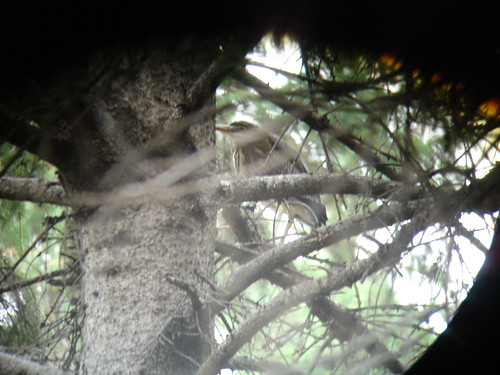Reflecting on this question, I reviewed my records. Since May 2009, I have been keeping track of bird observations in the Sculpture Garden. So far, I have seen 50 different species in or from the Garden. This includes unusual sightings such as the raft of American White Pelicans I saw flying high overhead on May 2, 2014 or the "just passing through" Magnolia Warbler from May 10, 2013.
Next, I narrowed my inquiry to consider how many species of birds might use the Garden for breeding purposes. Based on my observations, I have seen evidence of breeding for 12 species.
Below is complete list (thus far). Species in red exhibit evidence of breeding:
- Canada Goose
- Wood Duck
- Mallard (nest on the tiny island by Spoonbridge and Cherry)
- American White Pelican
- Green Heron (seen nesting in 2012, 2013, and 2014)
- Turkey Vulture
- Bald Eagle
- Red Tailed Hawk (nesting on the lighting structures near the neighboring baseball field)
- Rock Pigeon
- Mourning Dove (fledglings observed)
- Chimney Swift
- Red-bellied Woodpecker
- Downy Woodpecker
- Hairy Woodpecker
- Peregrine Falcon
- Yellow-throated Vireo
- Blue-headed Vireo
- Red-eyed Vireo
- American Crow
- Barn Swallow (possibly - based on observations of recently fledged young)
- Black-capped Chickadee
- White-breasted Nuthatch
- Brown Creeper
- Golden-crowned Kinglet
- Ruby-crowned Kinglet
- Hermit Thrush
- American Robin (several nests with young are observed every year)
- European Starling
- Cedar Waxwing
- Tennessee Warbler
- Orange-crowned Warbler
- Nashville Warbler
- American Redstart
- Magnolia Warbler
- Yellow Warbler
- Chestnut-sided Warbler
- Palm Warbler
- Yellow-rumped Warbler
- Chipping Sparrow
- Savannah Sparrow
- White-throated Sparrow
- Dark-eyed Junco
- Northern Cardinal (fledglings observed)
- Rose-breasted Grosbeak
- Red-winged Blackbird
- Common Grackle
- Brown-headed Cowbird (based on observing a fledgling being fed by a Chipping Sparrow)
- House Finch
- American Goldfinch
- House Sparrow









